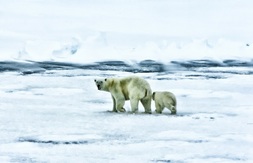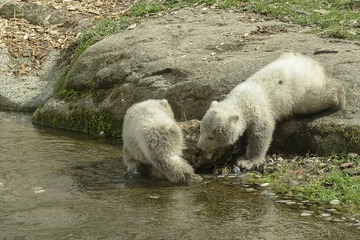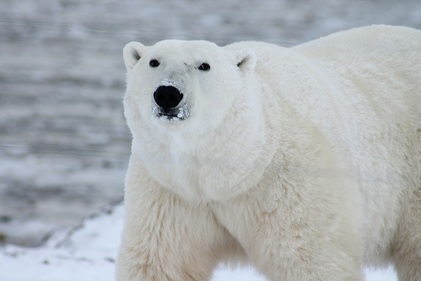|
The Polar bear is a breed of the bear family. It is a massive carnivorous animal weighing anywhere from approximately 380 -450kg. The polar bear is 1.3 Meter tall for adult males with a full body length of approximately 2.5-3Meters. The Polar bear is a great swimmer and will spend a lot of time hunting fishes and seals.
|

Polar bears fancy the cold and snow. They have white thick furs and thick fatty skins that allow them to live in areas of extreme cold. You will find many polar bears living in Canada, Norway, Greenland, Russia and of course Alaska. These are prime areas for the polar bears as they are also homes to another animal which is the main prey for polar bears, the seal.
Well aside from fish, polar bears love the taste of seals. The polar bear's main prey is the ringed seal. Polar bears usually hunt ringed seals by waiting for them to breathe at openings in the ice (leads) or at breathing holes. Polar bears will also stalk seals that are hauled out on top of the ice. The polar bears are real patient when it comes on to catching these seals as they can't out swim them so it is always a cat and mouse game when it comes on to polar bear and ring seals. The seals makes holes in the ice so that they can come out to breath. This is the time when the polar bear will try and strike to catch these seals.
The Seals surface about every five to fifteen minutes at one of these breathing holes. Seals also use air pockets trapped under the ice when available. The polar bear finds these breathing holes and just sits there and wait for the seal to come and get oxygen. The thing with this hunting method is that the bear may have to wait a pretty long time and chances are the seal may not come up at the breathing hole where the bear is waiting. The polar bear have gone hungry many nights using this method.
Even though Polar bear will enjoy a nice succulent seal, they will not starve themselves if none is available. They also dine on almost any other meat kind and vegetation available. The will consume small mammals, bird eggs, birds, whale remains, walrus, narwhal and some vegetation. Any sea mammal such as the Beluga or narwhal that has become trapped in small opening in a park ice (savatt) are very easy targets for Polar bears.

Polar bears will mate during the period of April, May to June. Almost all mating will occur on ice.
Female polar bears will give birth to two cubs about two month after they enter their maternity den.
- Newborns are 12 to 14 inches long (30–35 cm) and weigh a little over one pound (0.5 kg).
- The family remains in the den until March or early April. During her entire time in the den four to eight months—mother bear doesn't eat or drink. When she finally emerges with her cubs, she leads them to the sea ice so she can break her long fast by hunting seals.
Other than if the Polar bear is pregnant. The polar bear does not hibernate in dens like brown and black bears. Instead, adult male polar bears and non-pregnant females remain active throughout the year.
Pregnant female polar bears do a mini pre birth hibernation where they will dig a snow den, give birth, and emerge three months later. During this three months, the Polar bear eats nothing end will loose weight as she will simply live off her fat reserves.
When bears actually hibernate, their body goes through changes such as heart rate drop and lower body temperature. Mother Polar bears do not enter a state of deep hibernation because they need a higher body temperature in order to meet the demands of pregnancy, birth, and nursing.
Polar bears endangered
Because of ongoing and potential loss of their sea ice habitat resulting from climate change, polar bears were listed as a threatened species in the US under the Endangered Species Act in May 2008.
The survival and the protection of the polar bear habitat are urgent issues. Polar bears numbers are constantly monitored as well as their habitat.
Polar bear extinction


 RSS Feed
RSS Feed
